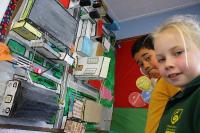Primary students learned the skills to be safe road users in a unit that crossed the curriculum.
A primary school tied earth science and safe travel together in an inquiry unit that also strengthened its teachers' pedagogical knowledge.
Health lessons get intermediate students thinking about road safety in relation to current events.
Onehunga Primary School - Choice lessons in staying safe
A three-dimensional map of local streets, mounted on a classroom wall, is impressive – colourful and so big that two students stand on chairs to point out their work.
Their year 2-3 class at Onehunga Primary School painted streets and cardboard buildings to map out the route taken during a walk to the beach. There's even miniature traffic lights marking where they practiced pedestrian safety under the watchful eye of a police officer invited along for the excursion.
'The creation of a 3-D map encouraged the students to do something new and different. This also integrated well with our sculpture focus for visual arts,' says teacher Jo-Mae Ballantyne about the creative map format.
All classes at Onehunga learned through an integrated curriculum unit based on The Big Event, an education resource designed by Pam Hook and Julie Mills for the NZ Transport Agency.
The resource features curriculum-aligned activities that ask children to 'explain how smart choices can result in safe travel'. The implication is that primary students don't simply learn about road safety but rather about how they can choose to think and act as road users.
This sort of active learning was evident at Onehunga. The map, tied to maths achievement objectives on position and orientation, was only a part.
Walking to the school's annual beach clean-up provided an occasion for teachers to wrap around learning from the health and English areas of the Big Event resource too. A sports and cultural ceremony at term's end was a further catalyst.
Teacher Namrata Ghadiyar began by asking her year 3-4 class to brainstorm safe walking practices. On the clean-up day, they put these into action at intersections and driveways. A week later, with the experience fresh in mind, the class used a part-whole map to figure out the function of each practice (such as using zebra crossings) and to talk about what would happen without that practice.
Primed with ideas, they wrote explanations about staying safe and included their own ideas for improving road safety. They thus built on their experiences to think for themselves.
'There's that deeper learning – they are predicting,' says Namrata. 'Takurangi writes "in the future I want to see when you get tickets to the big event, they come with bright jackets so you can be seen by people."'
Namrata and colleagues say the progressive structure of Big Event learning intentions helps students to advance. Reluctant writers gain experiences to draw on before putting pen to paper, for example.
Jan Downey's year 5-6 class were provoked into thought through questions like 'what if there were no footpaths?' Later, the class made safe practice brochures for various transport modes, all with international visitors in mind.
'They decided as a group what they should take out that wasn't necessary or had been repeated. Then they decided who was going to do each page – it's their own thinking,' says Jan.
Back in Namrata's class, four children wrote and acted out a play about staying safe in traffic. Joshua explains the plot, revealing how such child-citizens make sense of issues that hit the headlines.
'It was about some people trying to get to a rugby match between the All Blacks and the Wallabies and there's a big traffic jam and when they get to the stadium it's already halfway through,' he says.
Educator Pam Hook says teachers can help students make progress by giving them challenges pitched slightly ahead of their current abilities, and by explaining these clearly. Activities should be proximal, hierarchical, and explicit.
The same framework for learning came through in the learning intentions developed by Onehunga teachers. Words like evaluate, reflect, analyse, and explain showed students what was expected, while rubrics designed with SOLO taxonomy helped them assess their progress.
Progression of learning was evident among students who created technology prototypes for safe travel. They created and refined concepts, explained their design in writing and pictures, and later evaluated the effectiveness of their project, be it a reflective umbrella or a jersey fitted with glow sticks.
'We're making a safety flag, so that other people like drivers can see where you are,' says Jeremy as his group wraps up work. Reading through the explanations for each group's design showed creativity and purposeful thinking about how to stay safe – good indicators for their future.


